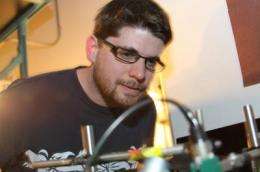Microbubbles to light the way to sentinel lymph nodes of breast cancer patients

Researchers at the University of California, San Diego are developing nonsurgical methods for identifying critical lymph nodes to help doctors determine courses of treatment for breast cancer patients. The "sentinel lymph node" is routinely biopsied or removed and dissected to determine the likelihood that the cancer has spread beyond the breast. Dr. Andrew Goodwin, a post doctoral fellow in the Department of Nanoengineering in the UC San Diego Jacobs School of Engineering recently received a Breast Cancer Postdoctoral Fellowship Award from the U.S. Department of Defense to use novel microbubbles to mark and interrogate the sentinel lymph node by means of a simple ultrasound scan.
"Since analysis of tumor stage is important for all breast cancer patients, this work would be expected to help many patients," explained Goodwin.
Cancer cells can detach from a primary tumor and enter the bloodstream by way of the lymph nodes. To determine if the cancer is spreading to other parts of the body, surgeons will biopsy or remove the lymph nodes to look for invading cells. Finding cancer cells in the lymph nodes often changes the course of treatment in an effort to kill any cancer cells that have already spread beyond the breast. Removing just the first, or sentinel, lymph node for analysis helps to reduce the likelihood of developing lymphedema, a painful, long-term swelling at the area of dissection.
The benefits of sentinel lymph node dissection for breast cancer patients were underscored by research findings recently published in The Journal of the American Medical Association.
However, identifying the correct lymph node to remove is not straightforward. Current methods require injection of radioactive colloids, which tend to blur at the injection site, or blue dye, which leaches into multiple nodes and can only be observed after opening up the patient. These "black box" methods provide little information about the structure of the lymph nodes at the tumor site, and both require the patient to be prepared for a surgery that may be unnecessary if the contrast administration is unsuccessful.
Ultrasound and Microbubbles
"I'm trying to develop a better way to mark the sentinel lymph node," says Goodwin. His approach involves using ultrasound – high-frequency sound waves used in medical imaging applications such as prenatal sonograms – and gas-filled microbubbles with fluorescent outer shells. These microbubbles capable of loading large amounts of dye are described in a recent article in the journal Soft Matter by Goodwin and coworkers.

If Goodwin's vision translates to the clinic, a physician would inject the fluorescent microbubbles into the tumor and then use ultrasound to visualize the bubbles as they drain away from the tumor and into the lymph nodes under the arm. Once the lymph nodes have been imaged and the sentinel lymph node identified, the radiologist will turn up the power of the ultrasound beam – but just in the area surrounding the sentinel lymph node. This will burst the microbubbles and release non-toxic fluorescent polymer that is designed to stick specifically in the lymph nodes for extended periods, allowing both the doctor and patient to adequately prepare for the lymph node dissection surgery.
For now, critical next steps include testing how the outer shell of the microbubbles interact with the lymph node lining, as well as tests in animal models.
More information: http://jama.ama-assn.org/content/305/6/569.full















